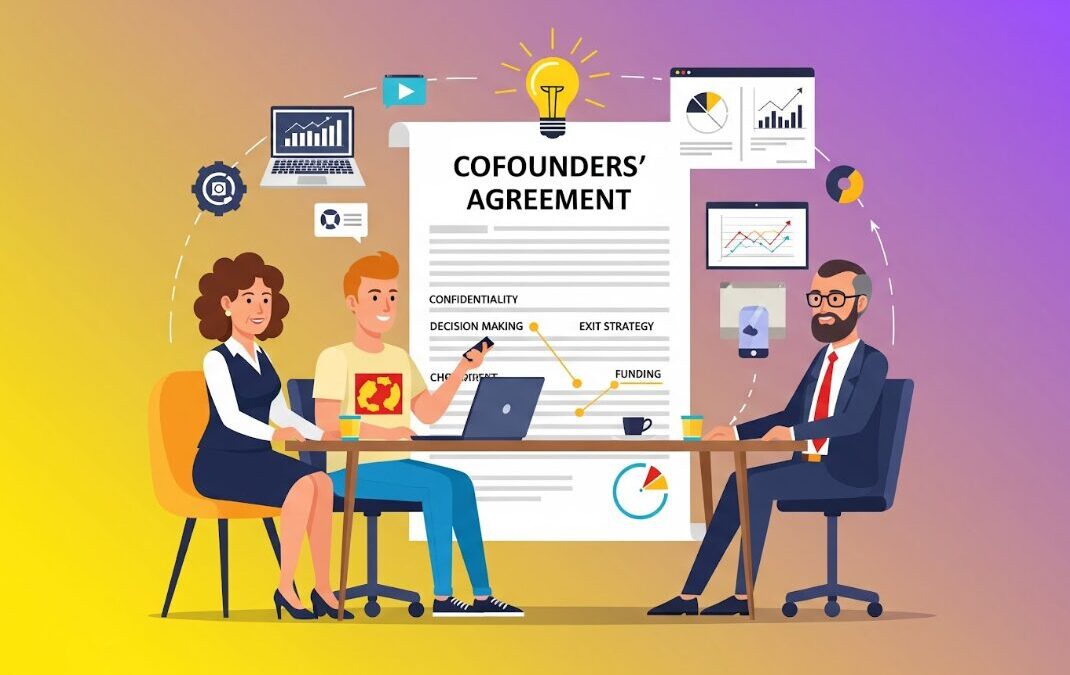A cofounders’ agreement, also known as the founders’ agreement, is the cornerstone of a successful company. Creating the contract and having the cofounders sign it is crucial during the early stages of building the startup. That’s how you’ll prevent the risks of disputes and conflicts that may arise.
When friends, colleagues, or like-minded individuals come together to form a startup, they need more than a shared vision. Common aspirations, goals, and a mission statement aside, they need to define the complete aspects of operating the company. That’s where the cofounders’ agreement comes in.

*FREE DOWNLOAD*
The Ultimate Guide To Pitch Decks
Understanding What a Cofounder’s Agreement Is
A cofounders’ agreement is a legally binding contract that the cofounders of a company enter into. This document acts as a foundation of the partnership and outlines their roles and responsibilities, along with the decision-making frameworks for the company.
You’ll include the complete terms and conditions of the collaboration and establish a clear and transparent understanding between the participants. The agreement serves as a roadmap detailing the company’s operational and management structure, along with the equity rights.
Setting up clear expectations between the cofounders enables efficient conflict resolution, thus securing the company’s long-term success and stability. But is this contract really necessary? You’d be surprised.
Business partners often make the critical mistake of assuming a robust working relationship can see them through challenges. While this factor is true, you should be prepared for the possibility that things may not progress as initially planned. Having failsafe measures is thus always advisable.
Disagreements can derail the company’s operations, but you can avoid this risk by drawing up the contract early on. You’ll work with expert legal advisors to draft the cofounders’ agreement at the onset of the company’s lifecycle.
It should be high on your list of priorities, with a business plan, pitch deck, and sorting intellectual property ownership. You’ll also outline the partners’ exit pathways and how to treat a potential dissolution of the partnership.
Clauses for managing the company’s sale, acquisition, or initial public offering (IPO) also form part of the cofounders’ agreement.

Raise Capital Smarter, Not Harder
- AI Investor Matching: Get instantly connected with the right investors
- Pitch & Financial Model Tools: Sharpen your story with battle-tested frameworks
- Proven Results: Founders are closing 3× faster using StartupFundraising.com
Essential Clauses in the Cofounders’ Agreement
Your legal advisors can assist you in designing the framework for an effective founders’ agreement. Several templates are also available online that you can customize according to your startup’s needs and cofounders’ relationships.
You’ll complete this legal formality before drawing up documents like the articles of association or articles of incorporation. Here are some of the most crucial clauses the document must have.
Names and Addresses of the Cofounders
The cofounders’ agreement includes the name of the startup, even if it is temporary and subject to change. Don’t delay drawing up the contract if you haven’t selected a name for the startup. You can agree to make the desired changes once you start with formal marketing and branding campaigns.
Along with the name, you’ll add an elevator pitch, which includes an overview of the business plan and mission statement. Also, add details about the company’s objectives and what you’re hoping to achieve with the organization.
Next, you’ll add the names, addresses, and roles of all the cofounders who are the official signatories to the contract. Don’t forget to define all the terms clearly to avoid any potential ambiguity. Further, the cofounders should agree to review the agreement at regular intervals to update it as needed.
This step ensures that the cofounders’ agreement evolves with the growing needs of the company and its founders.
Capital and Other Asset Contributions
This section of the document details the capital and other assets each of the cofounders contributes to the startup. These assets can be both–liquid cash and non-cash, such as physical property, tools, capital commitment, intellectual property, and skill sets.
When listing the non-cash contributions, you’ll assign a monetary value to each asset. If the founders are contributing cash capital, the contract will mention the terms. For example, the cash is a one-time investment. Or, the founder will continue to contribute a fixed sum throughout the startup’s lifecycle.
This section will also include information about non-refundable initial capital contributions that partners invest in the company and cannot claim. They must commit in writing to maintaining their holdings until the company is sold or liquidated.
The cofounders’ contract should include provisions for managing incoming founders, the equity stake they can get, and their rights. You can consider adding details about the capital they will be expected to contribute.
Ownership and Equity Structure
This is one of the most critical sections of the cofounders’ agreement, which clearly mentions the equity ownership structure. Put down the percentage that each founder owns and how the structure will change if a founder exits.
Establishing this division of equity in the initial stages can help you avoid conflicts and disputes. This division is calculated according to the contributions and experiences each founder brings to the table. Equity shares will also depend on the anticipated future value that the founder will contribute.
If the company is registered as an LLC, the founders’ agreement describes the management interest each founder owns. Most importantly, the contract specifies whether each founder has just an economic interest. Or if they also play an active role in the company’s management, and in what capacity.
Aside from the equity allotted to each founder, you’ll add information about the vesting schedule. This clause determines if the cofounders will earn equity as incentives over time, per their performance in the company. Or, if their equity will vest when the company is sold or goes public.
Adding this clause, along with a cliff period, secures the company against the risk of a cofounder exiting the company. If they leave prematurely, they could walk away with a significant chunk of the equity. This action could disrupt the company’s stability and operations.
Hampering the company’s ability to raise funding from investors is also a risk. Potential investors are likely to be wary of excessive dilution and may refuse to back the company. Adding the relevant info to the cofounders’ agreement will ensure transparency and fairness among the participants.
Salary and Compensation Structure for Founders
Most startup founders choose to forego taking a salary in the initial stages to conserve resources. However, it is crucial to mention a future compensation structure that founders can claim once the company is stable. Remember that every startup is unique, as is the relationship between founders.
Adopting fair and equitable compensation and salary policies ensures that the company remains strong and there are no disagreements. Ensure that the cofounders’ agreement includes this data.
This section will also include information about whether each founder will work full-time. Or dedicate a specific number of hours each week to the company.
Cofounder Roles and Responsibilities
This clause details each partner’s designation, roles, and responsibilities. Essentially, it specifies which founder is responsible for which tasks, thereby assigning accountability. As a result, you’ll ensure that there’s no duplication of efforts and any potential misunderstandings.
You’ll also establish reporting frameworks in the provisions so that the founders can regularly review and make decisions accordingly. In this way, you can make the necessary role adjustments to ensure that the participants align their activities. That’s how you’ll infuse efficiency and consistent growth.
Framing the Decision-Making Process and Voting Rights
The decision-making process and voting rights follow as part of the participants’ responsibilities in the cofounders’ agreement. The contract should specify the voting rights each cofounder has and how disputes will be resolved. It should also include specific frameworks for resolving stalemates.
Voting rights are typically assigned according to the equity ownership of each founder. However, the contract will specify the issues that will be up for voting and which founders will be allowed to vote. Also, specify veto rights, supermajority votes, and issues that will carry no voting rights.
Working out voting rights is crucial at this time since it could influence the privileges you grant to investors. They may require a board seat and decision-making rights to offer you capital.
Keep in mind that storytelling is everything in fundraising. In this regard, for a winning pitch deck to help you here, take a look at the template created by Peter Thiel, Silicon Valley legend (see it here) that I recently covered. Thiel was the first angel investor in Facebook with a $500K check that turned into more than $1 billion in cash.
Remember to unlock the pitch deck template that founders worldwide are using to raise millions below.
Intellectual Property (IP) Ownership
This clause in the cofounders’ agreement specifies that the intellectual property (IP) they create for the company is a company asset. If a founder contributes IP, the contract should mention this factor along with the terms for contributing the assets.
However, if they develop the IP during the course of the company’s operations, the assets will belong to the company. Further, any third parties hired to develop IP must sign assignment contracts and transfer ownership to the company. Don’t forget to specify the usage rights and their scope.
This section is crucial since the startup’s success hinges on the intangible assets and the products you create using them. They are pivotal in delivering that critical edge over the competition. These assets include product designs, technology, software, and ideas developed during company hours.
Any content that you create or purchase for the startup’s website, along with marketing materials, also constitutes IP. Any assets the founders or team members create using company equipment, such as computers, tablets, or phones, are company property. Ensure you specify these nuances in the contract.
Since the company owns the intellectual property, the cofounders’ agreement should also define how to treat their sale. For instance, making the decision to finalize the sale or using the proceeds from the sale.
Maintaining Confidentiality and Securing Company Secrets
Securing sensitive company data and other information is crucial for maintaining that competitive edge and protecting its reputation. You’ll also want to protect its trade secrets by ensuring secrecy and confidentiality. At the same time, you also want to specify what constitutes sensitive data.
The cofounders’ agreement outlines the founders’ obligations to protect the information even after their tenure with the company has ended. You’ll also mention the procedures for signing and retaining legally-binding NDAs when new employees join the company.
This section will clearly define the consequences of data and information breaches and the penalties that will apply.
Founder Exit Protocols and Non-Compete Provisions
The cofounders’ contract will detail the pathways for a founder to exit the company. You’ll include clauses that determine how to treat the equity they own and if it will revert to the company. Put down mechanisms for voluntary exits and buying back shares so that the transition is streamlined.
Setting the buyout price at fair market value is always advisable so the exiting founder gets equitable treatment. Specify that independent third parties will review the equity and assign value to it. The cofounders’ agreement also covers the event of a founder passing on or becoming incapacitated.
Post exits, the company will continue operating without hurdles, and the remaining founders will have control over their equity. Another facet of founder exits is the non-compete clause. Exiting partners must commit to refraining from competitive activities or soliciting customers and employees.
The non-compete clause prevents founders from undertaking any activities that can undermine the company’s stability, its operations, and customer base.
Drafting a well-structured agreement is only one of the many facets you should learn. If you need more information about how to launch a business, check out this video I created. You’re sure to find it helpful.
Dispute Resolution
The cofounders’ agreement should have mechanisms for resolving disputes and conflicts between the participants. It specifies whether they can resort to mediation or arbitration, along with details about choosing the mediator or arbitrator.
The jurisdiction for legal proceedings and cost allocation for managing disputes also features in the contract. This strategy helps the company avoid expensive, time-consuming, and disruptive litigation. Resolving disagreements quickly and amicably ensures stability for the company and protects its reputation.
Terminating the Cofounder’s Agreement/Dissolving the Company
This section of the contract determines the circumstances or events that can lead to dissolving the company and the agreement. You’ll specify the procedures for winding down the company and sharing its assets. Other aspects to address include the equity, responsibilities, and cofounders’ rights.
Including this information ensures that the company’s termination is completed in an orderly way, so there are no associated risks.
The Takeaway!
As a cofounder, don’t underestimate the importance of a well-drafted cofounders’ agreement for the company’s future stability and success. You’ll ensure efficiency and streamlined operations when participants in the contract are clear about their equity, rights, responsibilities, and roles.
Including information about intellectual property ownership and maintaining confidentiality secures the company. You’ll also address the possibility of disputes, bringing in new founders, and managing exiting founders. Getting these nuances sorted ensures alignment among your respective goals.
You’ll also safeguard each founder’s interests, prevent conflicts, and secure the company’s assets. The cofounders’ agreement is essentially the cornerstone for the startup’s long-term growth and stability.
You may also find our free library of business templates interesting. There, you will find every single template you need to build and scale your business completely, all for free. See it here.





Facebook Comments